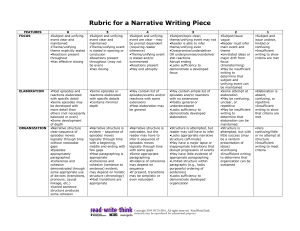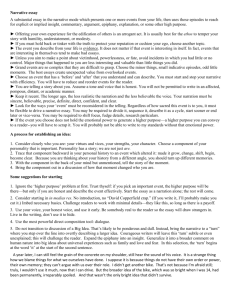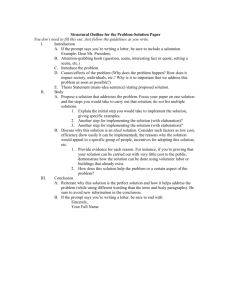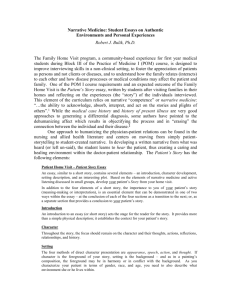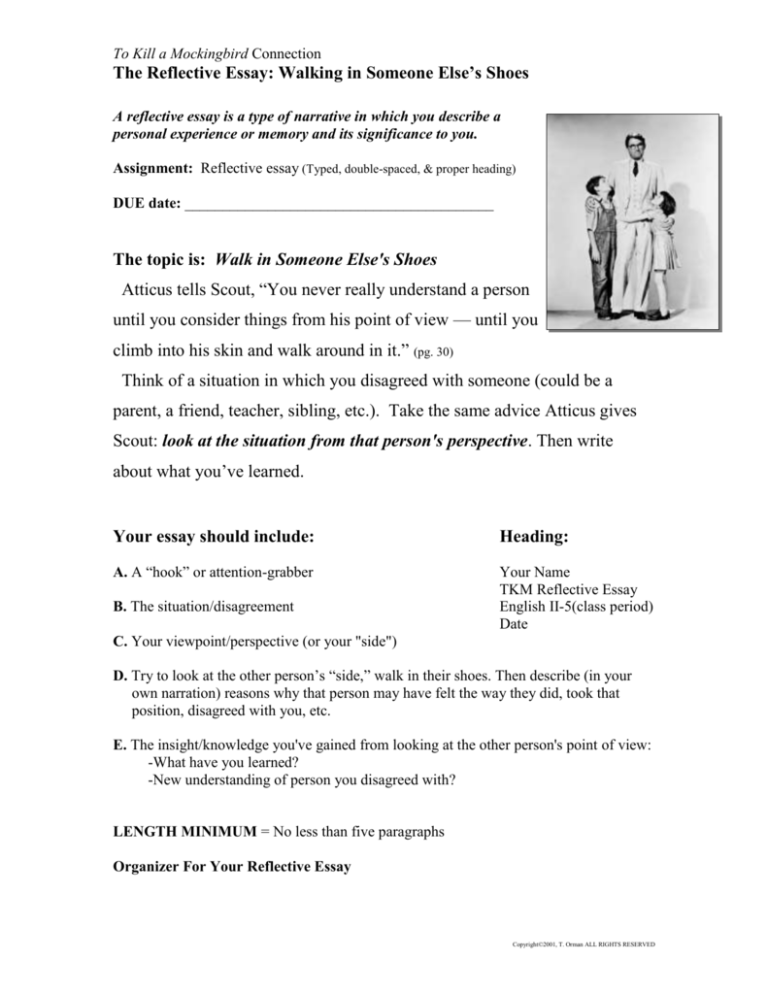
To Kill a Mockingbird Connection
The Reflective Essay: Walking in Someone Else’s Shoes
A reflective essay is a type of narrative in which you describe a
personal experience or memory and its significance to you.
Assignment: Reflective essay (Typed, double-spaced, & proper heading)
DUE date: _________________________________________
The topic is: Walk in Someone Else's Shoes
Atticus tells Scout, “You never really understand a person
until you consider things from his point of view — until you
climb into his skin and walk around in it.” (pg. 30)
Think of a situation in which you disagreed with someone (could be a
parent, a friend, teacher, sibling, etc.). Take the same advice Atticus gives
Scout: look at the situation from that person's perspective. Then write
about what you’ve learned.
Your essay should include:
Heading:
A. A “hook” or attention-grabber
Your Name
TKM Reflective Essay
English II-5(class period)
Date
B. The situation/disagreement
C. Your viewpoint/perspective (or your "side")
D. Try to look at the other person’s “side,” walk in their shoes. Then describe (in your
own narration) reasons why that person may have felt the way they did, took that
position, disagreed with you, etc.
E. The insight/knowledge you've gained from looking at the other person's point of view:
-What have you learned?
-New understanding of person you disagreed with?
LENGTH MINIMUM = No less than five paragraphs
Organizer For Your Reflective Essay
Copyright©2001, T. Orman ALL RIGHTS RESERVED
To Kill a Mockingbird Connection
The Reflective Essay: Walking in Someone Else’s Shoes
When disagreement
took place?
What happened?
Where?
What was my
argument?
My reasons for taking
this position:
What was the other
person’s argument?
Their reasons for
taking this position:
Why might they feel
this way? (Past
experience, concern,
hurt feelings, etc.)?
What I have learned
from looking at their
side?
Copyright©2001, T. Orman ALL RIGHTS RESERVED
Common Core Learning Standards: Writing (Grades 9-10)
3. Write narratives to develop real or imagined experiences or events using
effective technique, well-chosen details, and well-structured event sequences.
a. Engage and orient the reader by setting out a problem, situation, or
observation, establishing one or multiple point(s) of view, and introducing a
narrator and/or characters; create a smooth progression of experiences or
events.
b. Use narrative techniques, such as dialogue, pacing, description, reflection,
and multiple plot lines, to develop experiences, events, and/or characters.
c. Use a variety of techniques to sequence events so that they build on one
another to create a coherent whole.
d. Use precise words and phrases, telling details, and sensory language to
convey a vivid picture of the experiences, events, setting, and/or characters.
e. Provide a conclusion that follows from and reflects on what is experienced,
observed, or resolved over the course of the narrative.
Sample rubric for grading essay (based on Illinois standard writing rubric):
Focus
Elaboration (Support)
Organization
Conventions
Integration
1
1
1
1
2
2
2
2
2
4
3
3
3
3
6
4
4
4
4
8
5
5
5
5
10
6
6
6
6
12
See below for details for each number (even though conventions only goes up to 3, I
always make it six). Thank you! -Tracee Orman, Erie High School
Writing Rubric for Reflective/Narrative Essay
Focus
Elaboration
6 Subject and unifying event All major episodes are
clear and maintained
developed by specific detail
throughout with the event Episodes developed evenly (to
commented upon by the
the same degree of specificity
end of the composition
as appropriate)
Clearly sets purpose of
Considerable Elaboration
composition through
through multiple strategies
successful introduction
(e.g., points of
strategy
view/perspective, others’
Reactions are effectively
reactions, dialogue, etc.)
connected to unifying event Most episodes show significant
Effective closing which
depth of development
unifies the writing
Word choice enhances
specificity
Voice is appropriate for topic,
purpose, and audience
Organization
Integration
Narrative structure is clear, Fully-developed composition
effective, and appropriate –
for grade level
sequence of episodes is
Clear and purposeful Focus;
logically presented without
in-depth, balanced
gaps
Elaboration; sequence of
Appropriate and purposeful
episodes is coherently and
paragraphing
cohesively developed
throughout the composition
Coherence and cohesion
demonstrated by effective
and varied devices
(transitions, parallel
structure, pronouns, etc.)
Paragraph development
follows narrative sequence
All episodes and reactions
logically presented and
interrelated
Varied sentence structure
and word choice produce
cohesion
5 Subject and unifying event All major episodes developed Narrative structure is clear Developed composition for
by specific detail
and effective – sequence of
episodes is logically
Most Elaboration is even or
presented through time
balanced
without significant gaps
Some Elaboration through
multiple strategies (e.g., points All paragraphs appropriate
of view/perspective, others’
Coherence and cohesion
reactions, dialogue, etc.)
demonstrated by appropriate
devices (transitions, parallel
Word choice may enhance
structure, pronouns,
specificity
repetition, etc.)
Voice is appropriate for topic,
Most episodes and reactions
purpose, and audience
logically presented and
interrelated
Some varied sentence
structure and word choice
produce cohesion
Subject and unifying event Many major episodes
Narrative structure is
clear and maintained with
developed by specific detail;
evident – sequence of
event commented upon by some Elaboration may be
episodes moves through
the end of the composition general
time with a beginning, a
Sets purpose through
Elaboration may not be even or middle, and an ending with
few gaps
effective opening
balanced
Most paragraphs appropriate
Reactions clearly present
Some depth
and appropriate
Coherence (paragraph to
Word choice may enhance
paragraph) and cohesion
Has closing
specificity
(sentence to sentence)
Voice is present but
demonstrated with
inconsistent
appropriate devices
Coherence may depend on
holistic structure (e.g.,
chronology)
May have minor digressions
Most episodes logically
presented and organized
Subject and event clear; may Some major episodes
Narrative structure is
be prompt-dependent
developed by specific detail;
evident – sequence of
some Elaboration may be
episodes moves through
Minor Focus drift or lapses
general or repetitive
time with significant gaps
in logic
May be list of specific
Some appropriate
Reactions are present
episodes/reactions with some
paragraphing
May lack closing
extensions
May have a major
Lacks sufficiency to
Limited depth
digression
demonstrate developed
Voice shifts or disappears
May have intrusive or
Focus
inappropriate transitional
Lacks sufficiency to
devices
demonstrate developed
Elaboration
Lacks sufficiency to
demonstrate developed
Organization
clear and maintained
throughout with the event
commented upon by the
end of the composition
Clearly sets purpose through
effective opening or may
attempt more sophisticated
strategy (may not be
completely successful)
Reactions are relevant to
unifying event
Effective closing
4
3
grade level
All features not equally welldeveloped throughout the
composition
Depth is evident
Bare-bones-developed
composition for grade level
Simple and clear, presenting
nothing more than the
essentials
Limited depth
Partially developed
Some (or one) of the
feature(s) are not sufficiently
formed, but all are present
Inference is usually required
Continued…
Focus
Elaboration
Organization
Integration
2 Subject and/or event may be List of episodes and/or
1
vague
Unrelated or illogical ideas
or major drift from Focus
(composition consists mostly
of repetitions/redundancies)
Off-mode response (NOT
narrative showing a
sequence through time)
Multiple events without an
umbrella statement
No reactions
Insufficient writing to
determine that Focus can be
sustained
Subject/event unclear
Reactions absent
Insufficient writing to show
that criteria are met
reactions which may have
extensions
Most Elaboration is general or
consists of
repetition/redundancy
No evidence of suitable voice
Insufficient writing to
determine that the Elaboration
can be maintained
May lack clarity
Insufficient writing to show
that criteria are met
Structure is noticeable, but
the reader must infer it –
sequence of episodes moves
through time with either an
expository preview
developed by event/reaction,
OR an event developed by
reasons/examples
Limited evidence of
appropriate paragraphing
May have major
lapses/digressions
Insufficient writing to
determine that Organization
can be sustained
Little or no evidence of
structure
Insufficient writing to show
that criteria are met
Attempts to address the
assignment, but only
rudiments of techniques for
forming Focus, Elaboration,
and Organization can be
detected
Some confusion and/or
disjointedness
Lacks narrative structure
Insufficient writing to
determine that the features
can be maintained
Does not fulfill the
assignment; barely deals
with the topic; or does not
present most or all of the
features
Insufficient writing to show
that criteria are met
Conventions
3 Strong knowledge of conventions is demonstrated
Standards of punctuation, capitalization. and spelling are consistently followed – may have minor lapses
May have minor errors in usage and sentence formation
A variety of sentence structures is evident
2 Partial knowledge of conventions is evident
Severity and density of errors constitute a noticeable pattern
Little attempt at varying sentence structures
1 Little or no discernable knowledge of conventions
Severity and density of errors is such that meaning is impaired
Sentence structure is simplistic or in error

